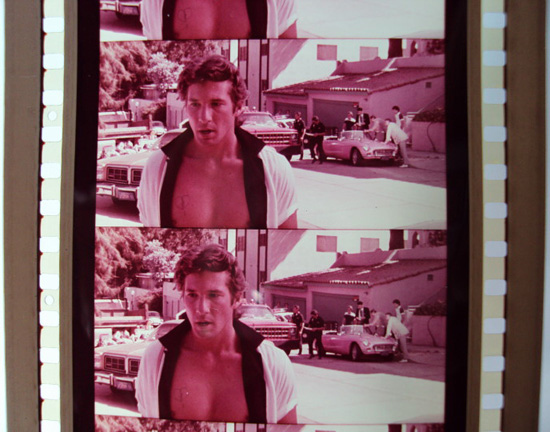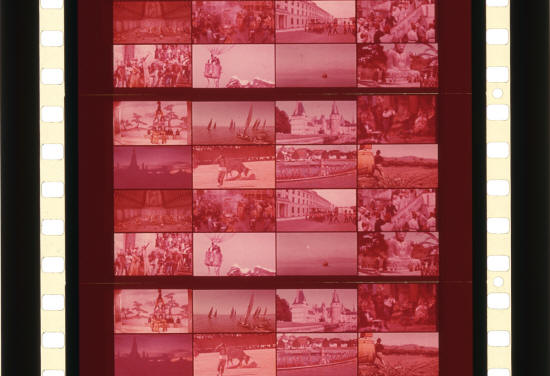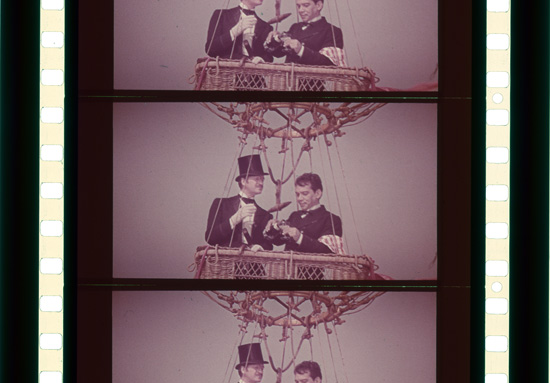The 70mm Trailer Anomaly |
Read more at in70mm.com The 70mm Newsletter |
| Written by: Brian Walters, Brisbane, Australia | Date: 17.04.2016 |
 Richard
Gere in "Breathless" NOT released in 70mm. Frames from a 70mm trailer. Richard
Gere in "Breathless" NOT released in 70mm. Frames from a 70mm trailer.In the hey day of 70mm theatrical presentation from the mid 1950s to 1970, when you saw a trailer in 70mm then you would have the opportunity to see that feature film in the same format, as you would expect. However when 70mm made a resurgence in the late 1970s until almost dying out again in the early 1990s this was not always the case, and so you had this format anomaly of perhaps seeing a trailer in the 70mm premium film format, that may never have a feature film release in the same format. The reasons for this were mainly operational ones due to changes in cinema design. When the video boom hit cinemas in the mid 1970s and large, often 70mm equipped cinemas were playing sessions to a handful of patrons the cinema industry had to come up with strategies to keep cinemas profitable. This led to the idea of the multiplex and then megaplex where patrons could have the choice of multiple film titles in up to thirty auditoriums at the one cinema location. This type of cinema needed a different type of film projection system to make it possible for fewer projection staff to run multiple screens for them to be profitable. The then recent film technology advancements of xenon light sources, long play platter systems, single turreted film projectors and automation systems made this possible. While this labour efficient system worked well, it would bring a range of restrictions, some economical and some presentational. In many cases it led to the end of the classic single screen 70mm cinema whose real estate foot print had become too valuable for only one screen to occupy and so were converted in many cases into multi screen complexes or sold off for their real estate value. In North America especially, because of limited advertising in cinemas, the film programme usually consisted of trailers and the feature film only. In automated multiplexes which were now generally equipped with a single film projector coupled to a long play platter system, as opposed to dual projectors doing change overs reel to reel, it made it impractical to play 35mm trailers and then a 70mm feature due to the need to convert the projector from one format to the other. To have two projectors and a platter system in multiple auditoriums so this was not necessary was far too expensive apart from the most prestigious of cinemas, so this led to the practice by film distributors of supplying trailers in 70mm film format for cinemas playing a 70mm feature so there would be no need for projector conversions from 35mm to 70mm and vice versa. |
More in 70mm reading: 70mm Clip Gallery: The 70mm Trailer Anomaly Around The 70mm World In Thirty Seven Days The H8 Down Under in70mm.com's list of films blown up to 70mm 70mm Engagements |
 Odd
sized "Around the World in 80 Days" pillar boxed 70mm widescreen trailer.
Approximately formatted to 1,5:1 with a mosaique of scenes from the film. Odd
sized "Around the World in 80 Days" pillar boxed 70mm widescreen trailer.
Approximately formatted to 1,5:1 with a mosaique of scenes from the film.Click to see enlargement So this situation of 70mm trailer advertisement came into being, even if many of the feature films would not ever be released in the 70mm format. Was this false advertising ? In the true sense of the word I guess not, as they were not advertising the film as a 70mm release, but more an operational necessity for multiplex cinemas where film distributors still wanted to play their trailers before 70mm feature film presentations. This practice would however have led to a certain amount of disappointment for a patron seeing and hearing 70mm quality when watching the trailer and then being dished up 35mm picture quality and stereo optical sound rather than the dynamic six track magnetic sound of the trailer, as 35mm digital sound formats would not appear until the early 1990s. Some of the excellent sounding 70mm trailer examples were for “The Fly“, “Commando“ and “Full Metal Jacket“, all wonderfully dynamic sounding trailers that far exceeded the sound of the feature presentations which were to be in 35mm stereo optical sound only. The picture quality of these trailers, even though only blow ups from 35mm, was also usually superior because of the improved brightness, picture stability and improved definition from longer focal length lenses employed with 70mm projection. The existence of these trailers also creates confusion for researchers and film historians of the 70mm format. Bill Kallay and Mike Coate have created the excellent 70mm blow up list which can be viewed on this web site, it lists all known 70mm blow up feature film releases. There could be no harder evidence you would think, no better exhibit “A“ than a frame of 70mm film of a film to prove that it was indeed released in the 70mm format. But misleadingly the frame may have come from a trailer of which there was no feature film ever released! Examples of these are “Purple Rain“, “The Best Of Times“ and “Wild Cats“ and many others. Further confusion created by 70mm trailers is the fact that sometimes they were not printed in the original aspect ratio of the feature film release. |
|
 Odd
sized "Around the World in 80 Days" pillar boxed 70mm widescreen trailer.
Approximately formatted to 1,5:1. Odd
sized "Around the World in 80 Days" pillar boxed 70mm widescreen trailer.
Approximately formatted to 1,5:1.Examples of this are trailers for “Top Gun“, “Ladyhawke“, and “Dune“ all pillar boxed to wide screen aspect ratio for their trailer release, but all released as full frame 70mm feature presentations. The opposite occurred for films such as “The Karate Kid“ which was a spherical wide screen 35mm release but the 70mm trailer was full frame and cropped in its height. These are just examples of film distributors seeing trailers as mere advertising and having an “anything goes“ attitude to their release format, but it is cause for misleading evidence when individual film frames are viewed, as it is virtually impossible to prove if a single 70mm frame came out of a feature or a trailer. Listed below are some of the films advertised in 70mm trailer format that never had a 70mm feature release: • D.O.A., Fast Forward, Darkman, Yentl, Revenge, Working Girl, Cocktail, Times Square, War of The Roses, Old Gringo, Tremors, Land Before Time, The Body Guard, Commando, The Fly, Harry & The Hendersons, Wild Cats, Legal Eagles, Pick Up Artist, Purple Rain, The Best Of Times, To Live & Die In L. A., Revenge Of Nerds 2, Full Metal Jacket, The Never Ending Story, Hello Again, Ruthless People, Turner & Hooch, Young Einstein, When Harry Met Sally, Superman IV, Breathless, Twins, Ghost, Youngblood, The Karate Kid, The Karate Kid III, Fatal Attraction, Back Roads, Young Einstein, The Falcon And The Snowman, Once Upon A Time In America & Frantic. • 70mm Clip Gallery: The 70mm Trailer Anomaly This anomaly lasted for a relatively short fifteen year period leading into the temporary demise of the 70mm release format due by and large to the advent of the various 35mm digital sound formats. It is ironic however that 70mm continues to survive today due in part to the application of the DTS / Datasat digital sound technology time code to the release print. This cheaper to produce sound format that has now replaced the expensive magnetic oxide sound tracks on 70mm release prints, had initially helped to kill off 70mm as a release format years before, after it was first applied to the 35mm release prints of “Jurassic Park“, but has now proved a saving grace to the 70mm release print format. |
|
| Go: back - top - back issues - news index Updated 22-01-25 |
